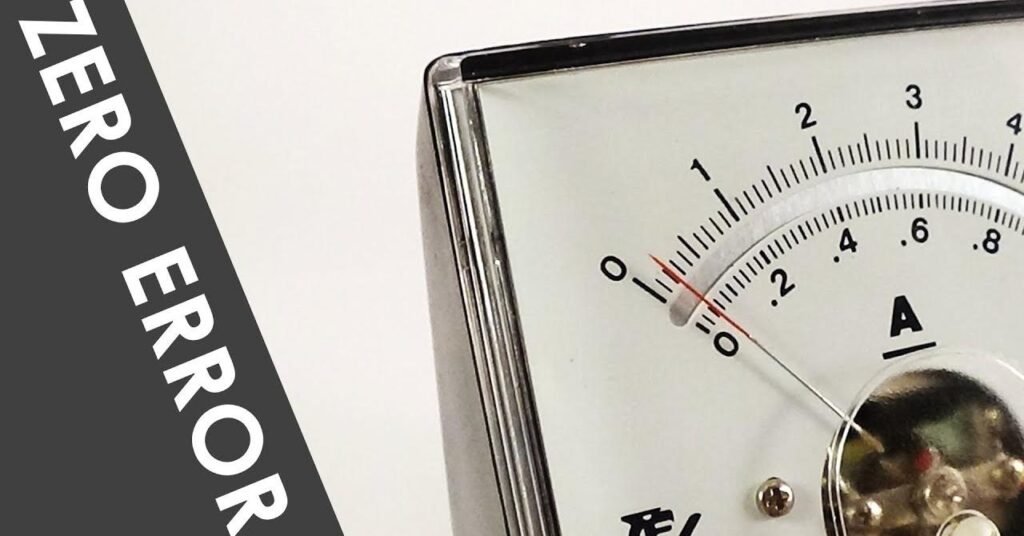Are you curious to know what is zero error? You have come to the right place as I am going to tell you everything about zero error in a very simple explanation. Without further discussion let’s begin to know what is zero error?
In the realm of precision and accuracy, zero error stands as a critical concept in measurement. Whether you are using a simple ruler or a sophisticated scientific instrument, understanding what zero error is and its impact on measurements is fundamental. In this blog, we will delve into the nuances of zero error, its types, and its importance in ensuring reliable and precise measurements.
What Is Zero Error?
Zero error in measurement refers to the deviation of a measuring instrument’s reading from the true or expected value when the input is actually zero. It represents an inherent inaccuracy in the instrument, affecting the reliability of measurements. Zero error can be positive, negative, or null, and it needs to be identified and accounted for to obtain accurate results.
Types Of Zero Error
- Positive Zero Error: When the instrument’s reading is more than the actual value, it is termed as positive zero error. This implies that the instrument starts measuring from a point above zero.
- Negative Zero Error: Conversely, negative zero error occurs when the instrument’s reading is less than the actual value. In this case, the instrument starts measuring from a point below zero.
- Null or No Zero Error: An ideal situation where the instrument’s reading is accurate when the input is zero. However, achieving a null zero error is often challenging in real-world instruments.
Significance Of Zero Error
Understanding and correcting for zero error is crucial for several reasons:
- Accuracy in Measurements: Zero error correction ensures that measurements are accurate and aligned with the true values.
- Consistency in Results: Identifying and compensating for zero error enhances the reliability and consistency of measurements over repeated trials.
- Calibration: Regular calibration of instruments helps minimize or eliminate zero errors, maintaining the precision of the measuring device.
Identification And Correction Of Zero Error
- Calibration: Regular calibration against known standards helps identify and correct zero errors. This involves adjusting the instrument to ensure accurate readings.
- Checking against Null Measurements: Comparing measurements with null or zero inputs helps detect zero errors. If the instrument does not read zero when it should, correction is necessary.
- Recording and Documentation: Maintaining records of zero error observations aids in consistent correction and ensures that subsequent measurements are adjusted accordingly.
Examples Of Zero Error
- Vernier Caliper: In a vernier caliper, if the zero mark on the vernier scale does not align with the zero mark on the main scale, a zero error is present.
- Analog Voltmeter: In analog voltmeters, the needle should ideally point to zero when there is no voltage. Any deviation from zero indicates a zero error.
Conclusion
In conclusion, zero error is a critical consideration in measurements that ensures the accuracy and reliability of data. From simple rulers to complex scientific instruments, understanding, identifying, and correcting zero errors is essential for obtaining precise results. Researchers, scientists, and even students conducting experiments must be mindful of zero errors to uphold the integrity of their measurements. In the world of precision, acknowledging and addressing zero errors is the key to achieving accuracy and consistency in every measurement.
FAQ
What Is No Zero Error In Physics?
In more detail, zero error is a type of systematic error that occurs when an instrument does not read zero when the quantity to be measured is zero. This error is significant because it can lead to inaccuracies in all measurements taken with that instrument, regardless of the actual value being measured.
What Is Zero Error On A Ruler?
A zero error occurs when a measuring instrument gives a reading when it should read zero. A reading error occurs when the observer misreads the instrument. In physics, measuring instruments are used to obtain accurate and precise measurements.
What Is Zero End Error?
Zero error is the false reading that an instrument shows when the true value of the measured quantity is zero. For example, even when the battery is turned off, the ammeter might show a slight deflection in the needle. the value by which the needle deflects is its zero error.
What Is Meant By Zero Error Of A Micrometer?
When the zero of the circular scale does not coincide with the reference line when the fixed stud and the movable stud are brought into contact without applying any pressure, we state that there is a zero error.
I Have Covered All The Following Queries And Topics In The Above Article
What Is Zero Error In Vernier Caliper
What Is Zero Error In Physics Class 11
What Is Zero Error In Physics
How Do You Apply The Correction Due To Zero Error
What Is Zero Error In Screw Gauge
What Is Zero Error Formula
What Is Zero Error Example
What Is Zero Error In Physics Class 9
What Is Zero Error






